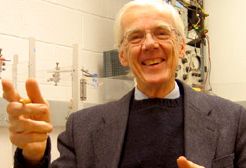This is Part 1 of 2 posts of in-depth analysis into the breakthrough work on high-fructose corn syrup and weight gain by Princeton researchers.
_______________
I have to admit that I was fascinated to watch the fallout over the Princeton HFCS study. What I thought would generate a “oh, look, another great reason to avoid HFCS!” reaction swiftly turned into “that study doesn’t prove a thing!!” — a sentiment that nutritionists, food business columnists and the Corn Refiners Association all, remarkably, shared.
Still, several questions raised by critics are worth addressing. We contacted the lead author of the Princeton study, Bart Hoebel Princeton researcher Bart Hoebel and crew prepare to feed rats HFCS. Photo: Princeton University, Office of Communications, Denise Applewhite, to see if he could shed some light on general questions surrounding the work as well as particular objections raised by physiologist Karen Teff, PhD of the Monell Chemical Senses Center in a blog post by Nicci Micco on Eating Well’s website.
Princeton researcher Bart Hoebel and crew prepare to feed rats HFCS. Photo: Princeton University, Office of Communications, Denise Applewhite, to see if he could shed some light on general questions surrounding the work as well as particular objections raised by physiologist Karen Teff, PhD of the Monell Chemical Senses Center in a blog post by Nicci Micco on Eating Well’s website.
The full email transcript appears below. One clarification in particular that I found interesting has to do with claims that the researchers didn’t directly compare HFCS consumption to table sugar consumption in a key experiment and thus are not able to conclude that HFCS causes more and worse weight gain over table sugar. In the experiment in question, researchers gave rats access to a 10% HFCS “drink” in addition to their normal feed. The rats gained excess weight in their abdomens (which is associated with metabolic disorders) and their triglyceride levels increased (also a symptom of metablolic disorders).
Dr. Hoebel points out that previous research has firmly established that if you give rats access to a 10% table sugar “drink” in addition to their normal feed, they do not gain additional fat. In other words, their bodies are able to metabolize the extra calories without creating more weight. This previous research is referenced in the study–but was apparently overlooked by critics. In other words, while the researchers didn’t compare HFCS to sugar directly in that particular experiment, we already know what happens to rats when you feed them small amounts of additional table sugar.
I understand that his answers to this and other criticisms won’t convince everyone, but I hope people will read the commentary below and think about just what level of “proof” we need before questioning the wisdom of making HFCS ubiquitous in our food system. For more thoughts on why the debate over HFCS has become so contentious, see Part 2 of this analysis, which will appear Monday.
The first two questions we had for Dr. Hoebel came from Grist Food Editor Tom Philpott:
Q: Do you have any particular comments on the issue of “statistical significance”? Is it true that the results in experiments 1 and 3 both lacked statistical significance, as some have claimed?
Hoebel: No, this is not true as a general statement. We reported results that are statistically significant as stated in the article. In Experiment 1, rats with 12-or 24-hour access to HFCS gained significantly more weight than the group with 12-hour access to sucrose. In Experiment 3, the main finding is that females rats with 24-hour access to HFCS weighed the most after 7 months , and this was overall (Repeated Measures Analysis of Variance) statistically different than the sucrose and chow fed controls.
This is important and meaningful because the 24-hour HFCS females had significantly heavier fat pads in the abdominal and uterine areas. They also had higher blood triglyceride levels than the other groups, which may have contributed to the body weight and body fat.
Q: Why did “Experiment 2” in your study, which compared rats’ access to HFCS over 12 and 24 hour time periods, not include sucrose? What are the clearest conclusions that can be drawn from its results as constructed? [Note to reader: this question is also addressed above–the bit about access to table sugar solution not seeming to show weight gain in rats.]
Hoebel: The goal of this paper was not exclusively to compare HFCS to sucrose. Rather, we were interested in assessing 1) limited vs. continuous access to HFCS, as our previous research has focused on binge eating of sugars, 2) differences in body weight gain as a results of access to HFCS that might result in males vs. females, and 3) the effects of long term access to HFCS on parameters such as triglyceride levels and fat accrual.
The vision of the paper was to study the effects of HFCS on body weight and obesity, not just to pit it against sucrose. The clearest conclusions that can be drawn from Experiment 2 are that, in male rats, long term consumption of HFCS increases triglyceride levels and fat accrual. To us, this is an important finding. It shows that not only will HFCS increase body fat, but it will also increase these obesogenic parameters
Next, we asked Dr. Hoebel to respond to criticisms of his work leveled by Dr. Karen Teff of the Monell Chemical Senses Center in a blog post by Nicci Micco on Eating Well:
Comment #1: The solutions of HFCS and sucrose used in all the studies—there were a few—in the Princeton report provided different levels of calories. (The HFCS, in fact, was lower in calories.)
Hoebel: It is true that the solutions of HFCS and sucrose were not offered as calorically equivalent. We note this in the Methods section of the paper. However, it is important to note that the HFCS consuming rats in Experiment 1, the short-term (2-month) study, showed greater gains in body weight while taking in fewer calories of sugar compared to the groups consuming sucrose. This led us to hypothesize that there might be something different about the way HFCS affects the body. Thus, we conducted Experiment 2, the long-term (6 month) study, and measurements showed that increased triglyceride levels and increased body fat were seen in the rats will access to HCFS, but not sucrose.
Comment #2: In one of the studies, the authors reported that male rats had a higher body weight after being exposed to 12 hours of access to the HFCS plus their typical rat chow compared to 1) standard chow alone, 2) 12 hours of access to sucrose with chow, and 3) 24 hours of access to sucrose with chow. However, they did not report or do the statistics on the change in weight. Thus, this is meaningless and poorly controlled.
Hoebel: One of the groups listed above is cited incorrectly; group 3 had 24 hours of HFCS and chow access (no sucrose access). As stated in the Methods section, the males in the three groups of Experiment 1 were “weight-matched”. That means the average (mean) weight of the rats in each group started out the same. Therefore the end-point body weights reported are in fact accurate representations of the mean body weight change. Ergo, the statistics were done on the appropriate measure. The result is meaningful and well controlled, given the use of not one but three comparison groups.
Comment #3: In a second experiment, they compared chow to chow-plus-HFCS for 24 hours and chow-plus-HFCS for 12 hours and found that access to the HFCS increased body weight. So what? Again, meaningless. This is like taking two groups of people, giving them the same diet but allowing one group to drink sweetened soda whenever they liked. Of course, they will gain weight because they are ingesting more calories. These findings have nothing to do with the controversy between sucrose and high-fructose corn syrup.
Hoebel: The result is, in fact, meaningful. As cited in the Discussion section, we have previously shown that the rats are able to compensate for the excess calories obtained when drinking 10% sucrose by taking fewer calories of chow and thereby maintaining a normal body weight. Therefore, we thought it was interesting and important to report that long-term access to HFCS causes rats to become overweight, whereas access to 10% sucrose does not. While comparisons were made to sucrose in some of the studies, this was not the sole focus of the paper. Rather, we were interested in seeing the effects of HFCS on body weight and obesogenic characteristics, and there were other variables of interest that were studied (as described in the response to the next comment).
Comment #4: Finally, in a third study, they show body weight as a percent of baseline (this is appropriate) and show that rats who had free access to both chow and HFCS gained a tiny bit more weight than chow alone, 12 hours of HFCS or 12 hours of sucrose. They did not compare it to the control of 24 hours of access to sucrose.
Hoebel: The statistical test (Repeated Measures Analysis of Variance) did show an overall significant difference between female rats with HFCS to drink 24-hr per day and the groups with chow alone or 12-hr access to sucrose, as described in the Results section. We did not compare 24-hr HFCS vs. 24-hr sucrose in this study because 1) in our previous studies (with both male and female rats) we have noted that rats with 24-hr access to 10% sucrose do not gain significantly more weight than chow-fed controls, and 2) in addition to comparing HFCS to sucrose, we were interested in the effects of limited (12-h) access to HFCS to see if it would cause binging that might enhance HFCS intake or body weight. Further, we chose to focus on assessing 12-h access as a variable because we did not know the effect of 12-hr vs. 24-hr HFCS access in female rats. This was of interest to us in light of the findings in Experiment 1 in males where we made that comparison, and because our laboratory has a long-standing interest in the effects of binge eating of palatable food. We explain and give the rationale for the choice of these variables in the Methods section.
So, yes the females drinking 24-hr HFCS showed a statistically significant increase in body weight. It is important and meaningful because these females had significantly heavier fat pads in the abdominal and uterine areas. They also had higher blood triglyceride levels than the other groups, which may have contributed to the body weight and body fat characteristics of obesity.
Our study in laboratory rats complements the growing body of literature suggesting that HFCS affects body weight and some obesogenic parameters. We cite in our paper additional evidence reported by other groups that supports our findings, and also acknowledge studies that suggest that HFCS does not affect body weight in ways different than that of sucrose. We acknowledge in the paper that at higher concentrations (e.g. 32%) sucrose has been shown to increase body weight. We are claiming, however, that at the concentrations we compared in this study, HFCS causes characteristics of obesity. The data show that both male and female rats are (1) overweight, (2) have heavier fat pads, particularly in the abdominal area and (3) have elevated circulating triglyceride levels.
For more information and references on this topic, as studied in both animals and humans, see a review published this year by George Bray, Curr Opin Lipidol. 2010 Feb;21(1):51-7.”Soft drink consumption and obesity: it is all about fructose”.



